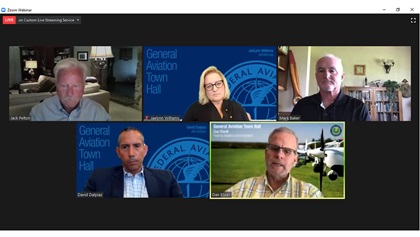FAA to extend pandemic SFAR beyond June 30
Online town hall event envisions aviation's 'new normal'
The FAA has a rule in the works to extend for a second time airman medical certificates that expired during the coronavirus pandemic and then had their expiration dates extended to June 30 under a special federal aviation regulation issued in April.
FAA Deputy Administrator Daniel Elwell announced that development June 18 during an online General Aviation Safety Town Hall on which AOPA President Mark Baker served as a panelist. Baker noted that action on the SFAR was GA pilots’ “number one issue” as the aviation sector adjusts to the unique challenges posed by the pandemic.
The need for an SFAR extension has become a source of many member inquiries to the AOPA Pilot Information Center as June 30—the day the window closes on some provisions—approaches.
Baker said interest also was running high among pilots working to stay safe and proficient, with many using AOPA’s online educational materials to keep sharp during the crisis.
Legal inquiries about buying aircraft were also up, he said—perhaps evidence of a “permanent shift” in air travel trends and an upbeat signal standing in sharp contrast to the pandemic’s earliest but short-lived effect of stifling much aviation activity.

The panel, Pandemic Impacts—Today and into the Future, one of the day’s two discussions, was moderated by Elwell, and included Baker, Experimental Aircraft Association CEO Jack Pelton, Jet Aviation Vice President of Flight Services David Dalpiaz, and Air Methods CEO JaeLynn Williams. Williams explored concerns confronted by air ambulance pilots and crewmembers and the training, protocols, and management of personal protective equipment and other resources that help them perform their lifesaving work. Through the crisis, air ambulance pilots had confronted new stress and had come to acknowledge that they were also health care providers, she said, noting the psychological shift that was involved “to think of yourself that way.”
Pelton said EAA’s members were interested in “the same technical issues about getting back into the air” that AOPA has been pressing for its members.
FAA Administrator Steve Dickson, who held a similar town hall meeting with airline representatives in May, noted in opening remarks several estimates of billions of dollars in lost revenue for airlines and airports “following a precipitous drop in traffic” caused by the pandemic.
Operations at major airports were down 92 percent between March and June, he said, underlining the impact with a nod to AOPA’s May 20 article that reported flight-tracking data showing that Cessna 172s frequently outnumbered the number of Boeing 737s in the air.
A key goal for aviation community members was to help each other by sharing safety practices, data, and insights as the industry gets back to a new normal, he said.
Baker noted that pilots appear to be flying some of those Skyhawks and other GA aircraft longer distances than before the pandemic, or making more one-day round trips—the activity helping to support FBO avgas sales, rental car businesses, and other nonaviation economic activity.
Responding to a question from a viewer of the event, he said he continued to see many future opportunities for youth in careers in every facet of aviation. He expressed confidence that “people are going to continue to move around this country.”
Fielding another viewer’s question about what a pilot should do “this weekend” before flying, Baker pressed the safety theme of the discussion, counseling pilots to prepare well and take a little extra time to preflight—“but we believe that the more you fly the safer you are, so get out there and fly,” he said.
In a second panel discussing Operational Experiences during COVID-19 – Aircraft, Airports and Infrastructure, Textron Aviation President Ron Draper said the company, parent of Cessna and Beechcraft, had stopped aircraft manufacturing for about eight weeks as the company developed factory safety protocols to "change the way we build airplanes."
As of mid-June, however, Textron was “largely back to work across the board,” he said. Piston-aircraft flying remained “pretty resilient throughout the period,” and business aviation, after a decline, was picking up. Used aircraft values had remained stable, suggesting “a lot of positives for GA going forward” as the industry figures out how to operate in the new coronavirus-influenced environment, Draper said.




